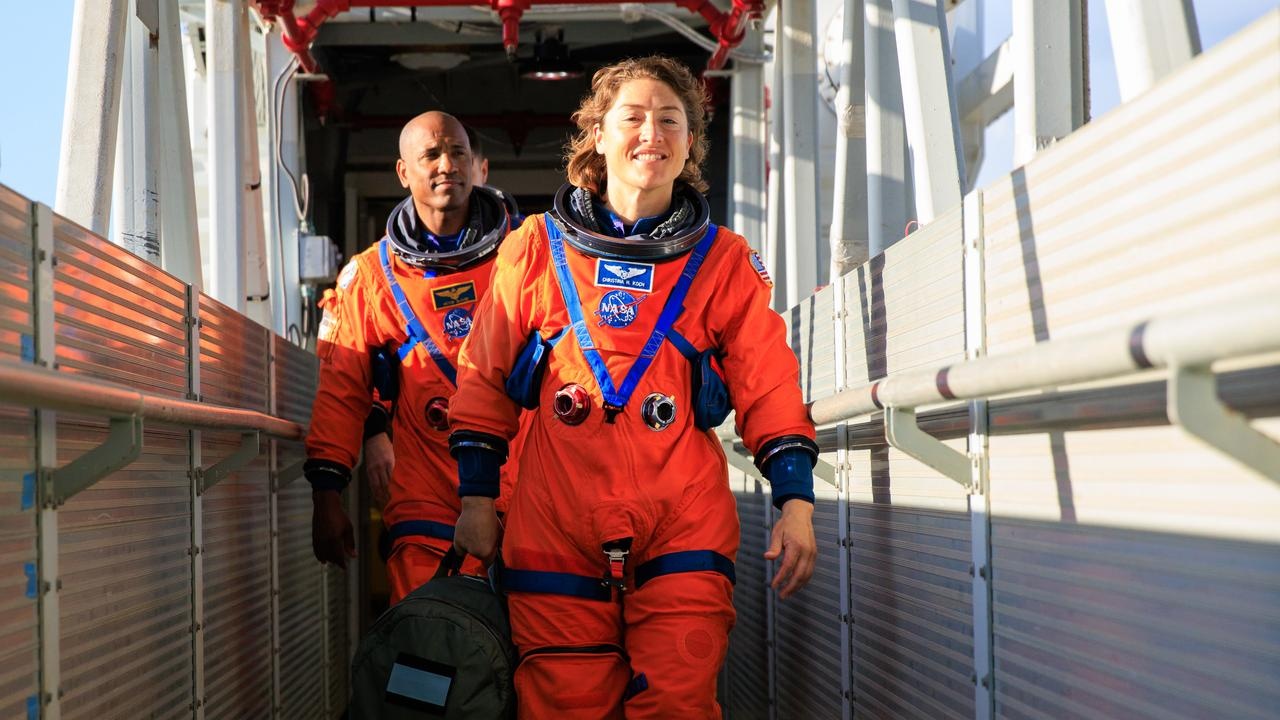Artemis 2 astronaut crew suits up for moon launch dress rehearsal (photos, video)
It's a lot like launch day, with everything but the rocket.
The Artemis 2 moon crew ran a launch simulation at NASA's Kennedy Space Center in Florida on Wednesday (Sept. 20). Just like on their big day, expected to happen in 2024, they donned spacesuits, drove out to the launch pad and climbed the mobile launcher that will one day bring them inside the powerful Space Launch System rocket and Orion spacecraft.
Even though the rocket and spacecraft weren't yet ready on Wednesday, "the test helps prepare the team for all the operations needed for launch," KSC officials wrote on X, formerly Twitter. The practice is needed as NASA will be making the first moon launch with humans onboard in 50 years, since 1972's Apollo 17.
Aboard the round-the-moon mission will be NASA commander Reid Wiseman, NASA pilot Victor Glover (the first person of color to leave Earth orbit), NASA mission specialist Christina Koch (the first woman to do so) and the Canadian Space Agency's Jeremy Hansen (the first non-American).
Related: Why Artemis 2 moon launch with astronauts is different from Artemis 1
The crew's visit also got attention from folks working around KSC.
That’s what I call a good morning Artemis 2 astronauts on their way to LC39B to rehearse launching to the Moon pic.twitter.com/Bw6uS8tWe8September 20, 2023
Reason #321 why I love my job! Artemis 2 Crew taking center stage! pic.twitter.com/VdQ9DJCtcJSeptember 20, 2023
Glover said one of the most memorable moments was reaching the crew access arm, according to a NASA statement.
Breaking space news, the latest updates on rocket launches, skywatching events and more!
"I just had images of all those Apollo launches and shuttle launches that I saw as a kid and it was unreal," Glover said. "I actually had to stop and just stay in the moment to really let it all sink in."
The mobile launcher at KSC's Launch Pad 39B (and related systems) have seven key tests to fulfill in the coming months before the rocket and spacecraft arrive ahead of launch day. NASA is also taking some engineering "lessons learned" from the ultimately successful launch of Artemis 1, an uncrewed orbital moon mission in 2022, which ran into several snags and delays during launch attempts and testing.
Here are the key tests to look for, in order, according to NASA.
Launch day simulation: As demonstrated on Wednesday, the astronauts donned their Orion spacesuits at KSC's Neil Armstrong Operations and Checkout Building and drove to the pad. They then ascended the mobile launcher and went onto the crew access arm, which is usually their access to Orion. "The SLS (Space Launch System) rocket and Orion will not be waiting for them this time, (but) the test will help prepare the team for all the operations needed to get the crew to their ride to the moon," NASA officials wrote.





Imagery test: Engineers will test the high-speed imagery cameras at Launch Pad 39B. This is not only useful for amazing launch shots, but also to look at "critical components and systems during the launch countdown and liftoff," NASA officials wrote.
Water flow tests: The thunderous launch will include the rapid release of 400,000 gallons (1.5 million liters) of water to dampen the vibrations SLS induces on the mobile launcher's deck and flame trench, along with the flame deflector on the pad. "Water helps deflect any over pressurization and suppress the sound produced at liftoff, and is critical for launch success," NASA officials wrote.
Hydrogen tank flow test (with changes): NASA had trouble getting Artemis 1 off the ground, in part due to hydrogen leaks. The agency has now put in an additional liquid hydrogen sphere tank at the launch pad, which will be monitored to make sure it works and that the gas flows into the SLS as designed. "Once the SLS elements are stacked, teams will demonstrate fueling operations at the pad, which will allow another opportunity to test the new tank prior to launch," NASA officials added.
Emergency egress demonstration: Teams will simulate astronauts at the launch pad during an emergency egress. Using water tanks to stand in for people, the tanks will be placed in baskets (hanging nearby the mobile launcher) and will be sent via zipline to emergency transport vehicles at the base of the launch pad for rapid evacuation. Two tests will take place, one at day and one at night, to simulate different launch scenarios.
Environmental control system and air and gaseous nitrogen test: This test is important to assure the air supply, temperature control and pressurization for both SLS and Orion. "Teams also will practice drying out the propellant lines and tanks on the mobile launcher and pad to ensure no moisture or contaminants remain in the system when teams start loading liquid hydrogen and liquid oxygen on SLS," NASA officials wrote. "Teams dry out these lines by removing air and gaseous nitrogen from the system."
Firing room testing: The seven tests conclude with examining all components in the firing room of the Launch Control System: software, imagery, communications and more. "For this specific evaluation, teams will test the audio loop the launch team uses to communicate with astronauts inside Orion during the launch countdown, as well as a switch that would be used in the unlikely event that a pad abort is required," NASA officials wrote.

Elizabeth Howell (she/her), Ph.D., was a staff writer in the spaceflight channel between 2022 and 2024 specializing in Canadian space news. She was contributing writer for Space.com for 10 years from 2012 to 2024. Elizabeth's reporting includes multiple exclusives with the White House, leading world coverage about a lost-and-found space tomato on the International Space Station, witnessing five human spaceflight launches on two continents, flying parabolic, working inside a spacesuit, and participating in a simulated Mars mission. Her latest book, "Why Am I Taller?" (ECW Press, 2022) is co-written with astronaut Dave Williams.




